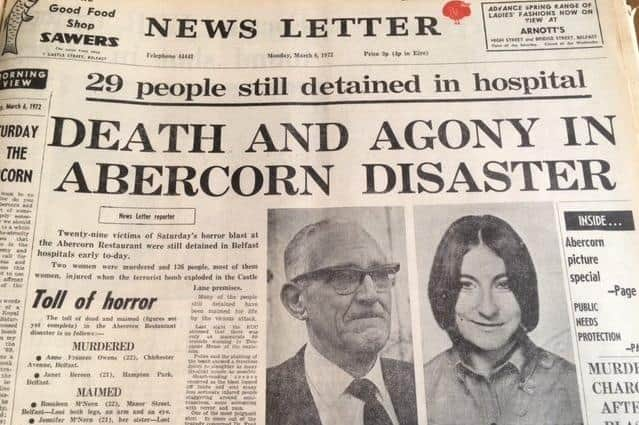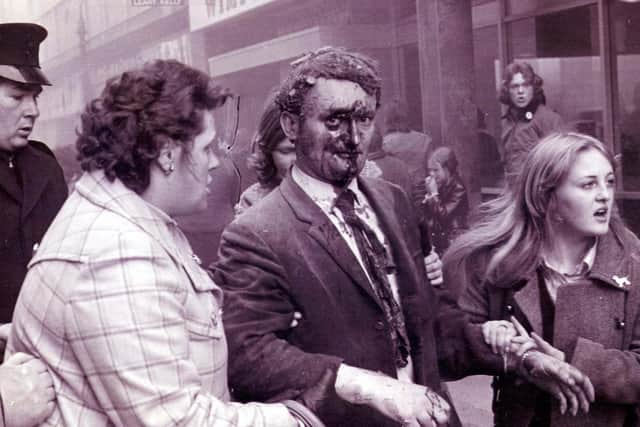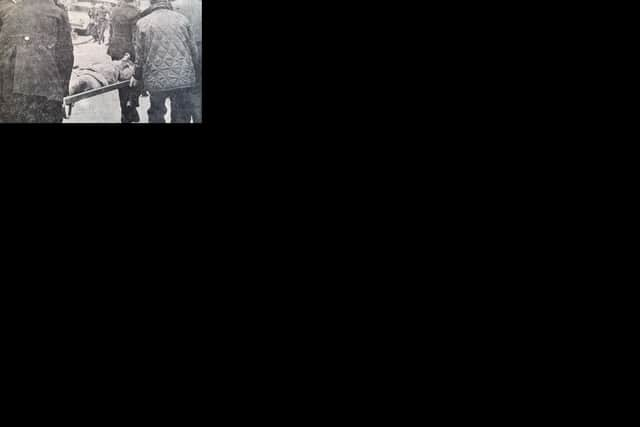Abercorn: widespread revulsion followed atrocity
and live on Freeview channel 276
Two young women died and several people lost limbs when a no-warning IRA bomb exploded inside the restaurant on a busy Saturday afternoon.
Janet Bereen, 21 and Ann Owens, 22, were killed when the bomb, which had been left in a bag under a table, exploded. Around 130 people were injured.
Advertisement
Hide AdAdvertisement
Hide AdAlthough no group has ever claimed responsibility for the attack, unionists were quick to blame the IRA – the bombing taking place at a time when both the Official IRA and the breakaway Provisionals were active.


On the Monday following the Saturday bomb attack, the News Letter carried quotes from an army officer who had helped at the scene.
He said: “I have never seen anything like it in my life. It was terrible.
“There were bodies lying all over the place; women and young girls lay screaming.
Advertisement
Hide AdAdvertisement
Hide Ad“It is sickening when you see the battle being carried to innocent civilians.


“This was a deliberate attempt to kill and maim innocent men, women and children.”
A day later (Tuesday, March 7), the paper also did a round-up of how the atrocity was reported across the UK and farther afield.
The article said the bombing had “prompted scathing editorials in many newspapers”.
Advertisement
Hide AdAdvertisement
Hide AdIt quoted the Daily Express as saying: “Within 24 hours of Mr [Harold] Wilson’s proposal that internment should begin to be phased out in April came Saturday’s ghastly attack, and attack aimed with horrifying success at killing or maiming women and children


“Neither wing of the IRA has so far disclaimed responsibility for that crime.”
While the Irish Independent said: “The brutish passions of the men of violence have led to this terrifying degree of bestiality.”
In a hard-hitting editorial the same day, the News Letter said: “As things stand today (Tuesday, March 7) everything would point to the likelihood of there being another Abercorn within hours, within days or within weeks. And most likely is, in fact, within days.
Advertisement
Hide AdAdvertisement
Hide Ad“So much for the lessons, bought by the public at such a high price, on Saturday afternoon.
“It is no point of the function of a newspaper to instruct governments on their responsibility or the security forces on their duties. But it must be our responsibility to point to the glaring vulnerability of the people of this country and this city who are now in the front line of the battle for the preservation of the British way of life.”
Newspapers were also reporting that high level discussions were taking place with a view to having permanent security checkpoints around the city, and possibly a curfew.
One report said: “Several months ago security chiefs discussed protection for downtown Belfast, but reached the conclusion that to blockade the area by curfew would strangle the commercial life of the city.”
Advertisement
Hide AdAdvertisement
Hide AdIt added: “Military commanders are known to favour the random check of vehicles and pedestrians in preference to static checkpoints and soldiers guarding premises.”
The coroner conducting the inquest described the bombing as “pathological murder of the most depraved kind”.
A warning had been phoned to the 999 emergency operators at 4.28pm but the device exploded just two minutes later, and before police had time to react.
The Lord Mayor of Belfast, Sir Joseph Cairns, said: “One can scarcely believe that anyone, however evil, could perpetrate such a crime.
Advertisement
Hide AdAdvertisement
Hide Ad“There can be no doubt that the citizens of Belfast are in the front line against a vicious, inhuman and hidden enemy.
“The citizens’ courage has been magnificent and I can only appeal to them to continue to show restraint in the face of such vile provocation.”
The day after the bombing, speaking at St Patrick’s Cathedral in Armagh, Catholic primate Cardinal Conway said that everyone with a spark of human feelings would be horrified at so many people being killed or maimed in the explosion.
“This was a horrible deed, and nothing can justify it,” he said.
Advertisement
Hide AdAdvertisement
Hide AdStormont minister Basil McIvor said: “It is almost impossible for me to find words that adequately express my horror.
After visiting the injured in hospital, Mr McIvor said his mind “ceased to grasp the reality of it all,” and added: “The tragedy was so great that it took on all the qualities of a nightmare.
“What are we to think of people who are prepared to bring down a country by mass slaughter or its innocents?
“This was a terrible crime against the whole of humanity.”
In the House of Commons, Secretary of State for the Home Department Reginald Maudling said the Abercorn murders and other attacks carried out that weekend were “the work of psychopaths”.
Advertisement
Hide AdAdvertisement
Hide AdOne eye-witness told the News Letter: “What I saw there I’ll never forget. It was absolutely horrifying.”
In the days following the Abercorn atrocity, relatives of the dead and injured filed past the hundreds of items recovered from the scene – many still splattered with blood – in an effort to reunite the owners with their property.
Coming just weeks after soldiers from the Parachute Regiment shot 13 people dead on Bloody Sunday, and just over a week after an IRA bomb at an Army barracks in Aldershot, the Abercorn attack was part of a spiral of violence that would make 1972 the most deadly year of the Troubles by far – with 476 people killed and many more injured.
It was the only year that Troubles deaths exceeded 300, although the casualty rate remained relatively high until it began to taper off from 1976 onwards.
Advertisement
Hide AdAdvertisement
Hide Ad——— ———
A message from the Editor:
Thank you for reading this story on our website. While I have your attention, I also have an important request to make of you.
With the coronavirus lockdowns having had a major impact on many of our advertisers — and consequently the revenue we receive — we are more reliant than ever on you taking out a digital subscription.
Advertisement
Hide AdAdvertisement
Hide AdSubscribe to newsletter.co.uk and enjoy unlimited access to the best Northern Ireland and UK news and information online and on our app. With a digital subscription, you can read more than 5 articles, see fewer ads, enjoy faster load times, and get access to exclusive newsletters and content.
Visit https://www.newsletter.co.uk/subscriptionsnow to sign up.
Our journalism costs money and we rely on advertising, print and digital revenues to help to support them. By supporting us, we are able to support you in providing trusted, fact-checked content for this website.
Ben Lowry, Editor